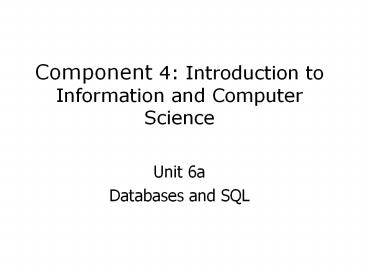Component 4: Introduction to Information and Computer Science - PowerPoint PPT Presentation
Title:
Component 4: Introduction to Information and Computer Science
Description:
Component 4: Introduction to Information and Computer Science Unit 6a Databases and SQL – PowerPoint PPT presentation
Number of Views:84
Avg rating:3.0/5.0
Title: Component 4: Introduction to Information and Computer Science
1
Component 4 Introduction to Information and
Computer Science
- Unit 6a
- Databases and SQL
2
Topics In This Unit
- Topic I Define and describe the purpose of
databases - Topic II Define a relational database
- Topic III Describe the SQL querying language
- Topic IV Design a simple relational database
using data modeling and normalization - Topic V Define the basic data operations for
databases and how to implement them in SQL - Topic VI Create simple querying statements for
the database
3
Topic I Define and Describe the Purpose of
Databases
- Storage prior to databases
- Other forms of storing data
- Purposes of databases
- Database hierarchy and terminology
- Deletion anomaly
4
Data Storage Prior to Databases
- Disk file storage
- Lists stored on disk
- Problems/shortcomings of disk file storage
- Data was repeated in multiple disk files (each
file needed to have customer identification data) - Only key data is repeated in a database.
5
Data Storage Prior to Databases Cont.
- A change to repeated data meant that all
locations of the data had to be updated. - A change to data in a database is usually only
done in one place. - Security risks were relatively high
- Database security, while still being a problem
provided less risk than disk files. - Conflicting data storage was relatively high
- Conflicting data in a database is rare
6
Problems with Data Storage Prior to Databases
Cont.
- If you kept more than one kind of data in a file
and you deleted one type, you deleted the other
type along with it - Database provided a way to delete each kind of
data without deleting any other types. - Required transaction fields for a new potential
customer might mean that you couldnt add new
customer information without there being a
transaction. - Database splits the information so that the new
customer information can be added.
7
Problems with Data Storage Prior to Databases
Cont.
- All data on a disk file record had to be input
even if you didnt need all the data. I/O is the
slowest thing that the computer does. - Data from a database can be input selectively
- Data from a disk file often required special
programming code to be processed. - Databases require less special coding
8
Other Methods of Data Storage
- Arrays are used in programs to store relatively
small amounts of repetitive data - Databases can store large amounts of repetitive
data - Spreadsheets store data that must be visible all
the time. - Data in a database is not visible all the time.
- Conclusion Databases are a powerful way to store
data
9
Spreadsheet Business Example
10
Purpose of a Database
- Receive data
- Store data in a unique repetitive fashion
- Retrieve data on command
- Provide internal security
11
Hierarchy and Terminology of a Database
- Data
field - File Record Elementary
data - Database Table Row Column
- Tuple Attribute
12
Fixing the Deletion Anomaly































